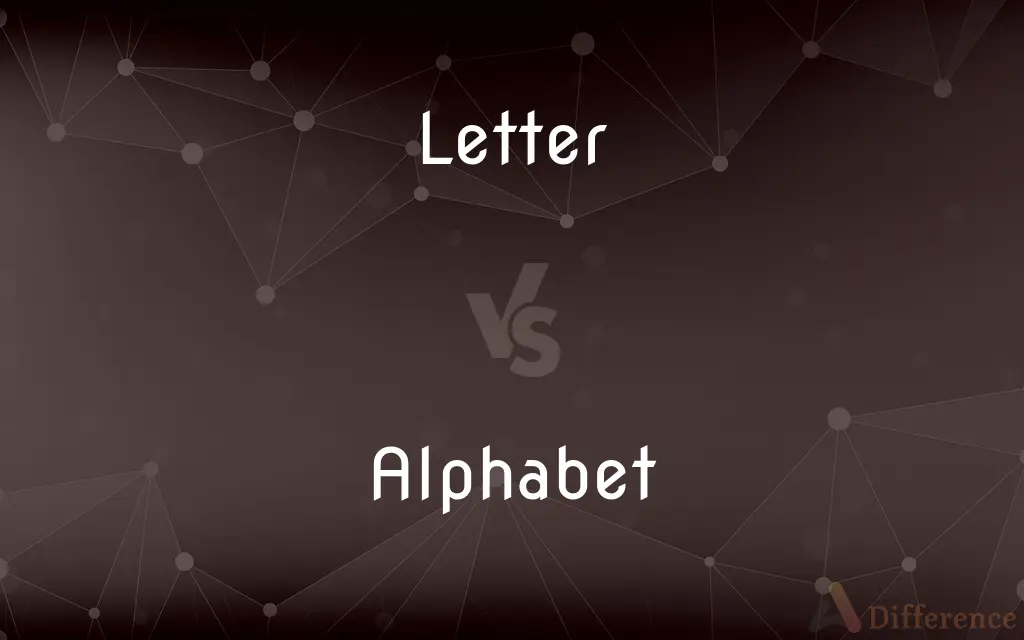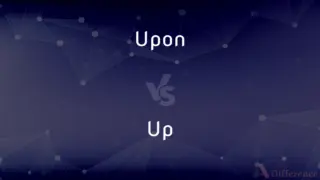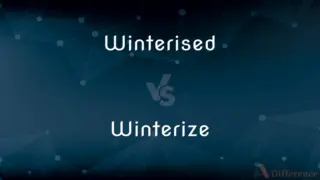Letter vs. Alphabet — What's the Difference?
Edited by Tayyaba Rehman — By Fiza Rafique — Updated on October 13, 2023
A letter is an individual character used in writing. The alphabet is a set of letters used in a particular language. While a letter stands alone, the alphabet represents the collection of letters in a language.

Difference Between Letter and Alphabet
Table of Contents
ADVERTISEMENT
Key Differences
A letter is a fundamental unit of the written language. It represents a sound or a combination of sounds in spoken words. Letters are the basic building blocks that come together to form words, sentences, and paragraphs. On the other hand, an alphabet is an organized set of letters used in a language. It is the complete collection of letters that a language utilizes to express thoughts, ideas, and information.
While each letter has its own identity and sound representation, the alphabet is the system that organizes these letters in a specific sequence. For instance, the English language has 26 distinct letters, from A to Z. The English alphabet, in contrast, refers to the entire set of these 26 letters arranged in a specific order.
It's essential to distinguish between a letter and the alphabet in contexts like education. When teaching children, for instance, they first learn individual letters—understanding their shapes, sounds, and how to write them. Only after grasping these basics do they move on to understanding the concept of the alphabet, which is the structured collection of all these letters.
The diversity in human languages is reflected in the variety of alphabets used around the world. Some alphabets, like the Cyrillic or Greek, have different sets of letters than the English one. In these systems, while the concept of a letter remains constant—a singular representation of sound—the alphabet varies, incorporating different letters and sometimes even embracing different writing directions.
Comparison Chart
Definition
Individual character in writing.
Set of letters used in a language.
ADVERTISEMENT
Represents
A sound or combination of sounds.
Collection and order of all letters in a language.
Count in English
26 distinct letters.
One alphabet (comprising 26 letters).
Example
A, B, C (individual characters).
A to Z (entire set).
Use in education
Taught for recognition and sound representation.
Introduced as a system after understanding individual letters.
Compare with Definitions
Letter
Individual character in writing.
The letter M stands for Mountain.
Alphabet
Foundation of written communication.
Each language has its unique alphabet.
Letter
Singular element of the alphabet.
Without the letter U, the word house would be hose.
Alphabet
Ordered set of letters in a language.
The English alphabet starts with A and ends with Z.
Letter
A character representing one or more of the sounds used in speech; any of the symbols of an alphabet
A capital letter
Alphabet
Complete set of letters.
The alphabet song helps children learn the sequence of letters.
Letter
A written, typed, or printed communication, sent in an envelope by post or messenger
He sent a letter to Mrs Falconer
Alphabet
An alphabet is a standardized set of basic written symbols or graphemes (called letters) that represent the phonemes of certain spoken languages. Not all writing systems represent language in this way; in a syllabary, each character represents a syllable, for instance, and logographic systems use characters to represent words, morphemes, or other semantic units.The first fully phonemic script, the Proto-Canaanite script, later known as the Phoenician alphabet, is considered to be the first alphabet, and is the ancestor of most modern alphabets, including Arabic, Cyrillic, Greek, Hebrew, Latin, and possibly Brahmic.
Letter
The precise terms of a statement or requirement; the strict verbal interpretation
We must keep the spirit of the law as well as the letter
The officer in the incident got in trouble for following the letter of the law
Alphabet
The letters of a language, arranged in the order fixed by custom.
Letter
Literature
The world of letters
Alphabet
A system of characters or symbols representing sounds or things.
Letter
A style of typeface.
Alphabet
A set of basic parts or elements
"genetic markers ... that contain repeated sequences of the DNA alphabet"(Sandra Blakeslee).
Letter
Inscribe letters or writing on
Her name was lettered in gold
Alphabet
The set of letters used when writing in a language.
The Greek alphabet has only twenty-four letters.
In the first year of school, pupils are taught to recite the alphabet.
Letter
Be given a school or college initial as a mark of proficiency in sport
In high school she lettered in soccer, basketball and softball
Alphabet
A writing system in which letters represent phonemes. Contrast e.g. logography, a writing system in which each character represents a word, and syllabary, in which each character represents a syllable.
Letter
A written symbol or character representing a speech sound and being a component of an alphabet.
Alphabet
A writing system in which there are letters for the consonant and vowel phonemes. Contrast e.g. abjad.
Letter
A written symbol or character used in the graphemic representation of a word, such as the h in Thames. See Note at Thames.
Alphabet
(computer science) A typically finite set of distinguishable symbols.
Let be a regular language over the alphabet .
Letter
A written or printed communication directed to a person or organization.
Alphabet
An individual letter of an alphabet; an alphabetic character.
Letter
Often letters A certified document granting rights to its bearer.
Alphabet
The simplest rudiments; elements.
Letter
Literal meaning
Had to adhere to the letter of the law.
Alphabet
An agent of the FBI, the CIA, or another such government agency.
Letter
Literary culture; belles-lettres.
Alphabet
(rare) To designate by the letters of the alphabet; to arrange alphabetically.
Letter
Learning or knowledge, especially of literature.
Alphabet
The letters of a language arranged in the customary order; the series of letters or signs which form the elements of written language.
Letter
Literature or writing as a profession.
Alphabet
The simplest rudiments; elements.
The very alphabet of our law.
Letter
A piece of type that prints a single character.
Alphabet
To designate by the letters of the alphabet; to arrange alphabetically.
Letter
A specific style of type.
Alphabet
A character set that includes letters and is used to write a language
Letter
The characters in one style of type.
Alphabet
The elementary stages of any subject (usually plural);
He mastered only the rudiments of geometry
Letter
An emblem in the shape of the initial of a school awarded for outstanding performance, especially in varsity athletics.
Alphabet
System organizing written language.
The Greek alphabet differs from the English one.
Letter
To write letters on
Lettered the paper.
Alphabet
Collection of written symbols for language.
The Cyrillic alphabet is used in Russian.
Letter
To write in letters
Lettered our name on the mailbox.
Letter
To write or form letters.
Letter
To earn a school letter, as for outstanding athletic achievement
She lettered in three collegiate sports.
Letter
A symbol in an alphabet.
There are twenty-six letters in the English alphabet.
Letter
A written or printed communication, generally longer and more formal than a note.
I wrote a letter to my sister about my life.
Letter
The literal meaning of something, as distinguished from its intended and remoter meaning (the spirit).
Letter
Literature.
Benjamin Franklin was multiskilled – a scientist, politician and a man of letters.
Letter
(law) A division unit of a piece of law marked by a letter of the alphabet.
Letter (b) constitutes an exception to this provision.
Letter
A size of paper, 8½ in × 11 in (215.9 mm × 279.4 mm, US paper sizes rounded to the nearest 5 mm).
Letter
A size of paper, 215 mm × 280 mm.
Letter
Clipping of varsity letter
Letter
A single type; type, collectively; a style of type.
Letter
One who lets, or lets out.
The letter of a room
A blood-letter
Letter
(archaic) One who retards or hinders.
Letter
(transitive) To print, inscribe, or paint letters on something.
Letter
To earn a varsity letter (award).
Letter
One who lets or permits; one who lets anything for hire.
Letter
One who retards or hinders.
Letter
A mark or character used as the representative of a sound, or of an articulation of the human organs of speech; a first element of written language.
And a superscription also was written over him in letters of Greek, and Latin, and Hebrew.
Letter
A written or printed communication; a message expressed in intelligible characters on something adapted to conveyance, as paper, parchment, etc.; an epistle.
The style of letters ought to be free, easy, and natural.
Letter
A writing; an inscription.
None could expound what this letter meant.
Letter
Verbal expression; literal statement or meaning; exact signification or requirement.
We must observe the letter of the law, without doing violence to the reason of the law and the intention of the lawgiver.
I broke the letter of it to keep the sense.
Letter
A single type; type, collectively; a style of type.
Under these buildings . . . was the king's printing house, and that famous letter so much esteemed.
Letter
Learning; erudition; as, a man of letters.
Letter
A letter; an epistle.
Letter
A telegram longer than an ordinary message sent at rates lower than the standard message rate in consideration of its being sent and delivered subject to priority in service of regular messages. Such telegrams are called by the Western Union Company day letters, or night letters according to the time of sending, and by The Postal Telegraph Company day lettergrams, or night lettergrams.
A strange lock that opens with AMEN.
Letter
To impress with letters; to mark with letters or words; as, a book gilt and lettered.
Letter
A written message addressed to a person or organization;
Mailed an indignant letter to the editor
Letter
The conventional characters of the alphabet used to represent speech;
His grandmother taught him his letters
Letter
A strictly literal interpretation (as distinct from the intention);
He followed instructions to the letter
He obeyed the letter of the law
Letter
An award earned by participation in a school sport;
He won letters in three sports
Letter
Owner who lets another person use something (housing usually) for hire
Letter
Win an athletic letter
Letter
Set down or print with letters
Letter
Mark letters on or mark with letters
Letter
A written symbol representing a sound.
The letter A is the first letter of the English language.
Letter
Basic building block of words.
The word cat is made of three letters.
Letter
Graphical representation of speech sounds.
The letter E is the most commonly used letter in English.
Common Curiosities
How does an Alphabet differ from a Letter?
The alphabet is a set of letters used in a language, while a letter is a singular character.
What is a Letter?
A letter is an individual character used in writing.
How many Letters are in the English Alphabet?
The English alphabet consists of 26 letters.
Is a Letter always vocalized the same way?
No, the pronunciation of a letter can vary based on the language and context.
Can a Letter represent multiple sounds?
Yes, depending on the language and context, a letter can have different phonetic values.
Can a language have more than one Alphabet?
Typically, a language uses one primary alphabet, but there can be variations or modified scripts.
Do all languages use an Alphabet system?
No, some languages, like Chinese, use logographic systems instead of alphabetic ones.
How did the concept of the Alphabet originate?
Ancient civilizations developed alphabets to standardize and simplify written communication.
Why is the Alphabet taught in order?
The order helps in systematic learning and memorization.
Is each Letter associated with a specific sound?
Generally, yes, but the sound can vary by language or word context.
What is the first Letter of the English Alphabet?
The first letter is "A."
Are Alphabets the same across languages?
No, different languages can have different alphabets with varying letters.
What's the purpose of teaching the Alphabet to kids?
It lays the foundation for reading, writing, and understanding the language structure.
Why is it important to know individual Letters?
Recognizing letters is crucial for reading, writing, and comprehension.
Which Alphabet is the oldest known to history?
The Phoenician alphabet is among the oldest, which influenced many modern alphabets.
Share Your Discovery

Previous Comparison
Upon vs. Up
Next Comparison
Winterised vs. WinterizeAuthor Spotlight
Written by
Fiza RafiqueFiza Rafique is a skilled content writer at AskDifference.com, where she meticulously refines and enhances written pieces. Drawing from her vast editorial expertise, Fiza ensures clarity, accuracy, and precision in every article. Passionate about language, she continually seeks to elevate the quality of content for readers worldwide.
Edited by
Tayyaba RehmanTayyaba Rehman is a distinguished writer, currently serving as a primary contributor to askdifference.com. As a researcher in semantics and etymology, Tayyaba's passion for the complexity of languages and their distinctions has found a perfect home on the platform. Tayyaba delves into the intricacies of language, distinguishing between commonly confused words and phrases, thereby providing clarity for readers worldwide.














































